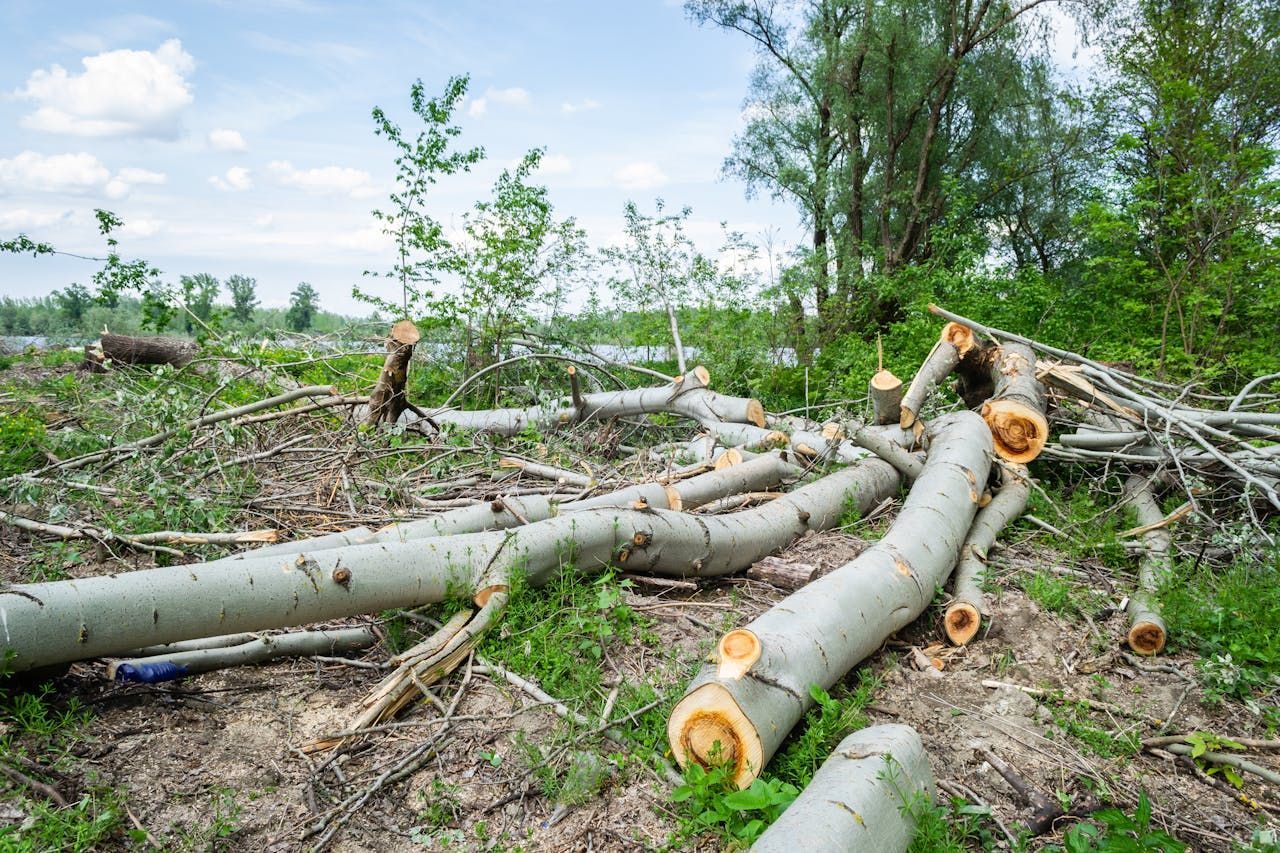Pruning Your Trees for Storm Preparedness: Why It’s Important

Strong winds and heavy storms can cause serious damage to our landscapes, especially when trees aren't properly maintained. When branches snap or entire trees fall, they can damage roofs, block driveways, or even injure someone. That’s why storm tree pruning is not just a seasonal task—it’s a crucial part of responsible property maintenance.
At
Fowlkes Tree And Stump Removal, we believe in being proactive. Through
tree pruning for safety, we help homeowners prepare for severe weather before it arrives. In this blog, we'll explain why pruning matters, how it helps, and when to take action. Let’s get your yard storm-ready.
Why Storm Tree Pruning Matters for Every Homeowner
We all enjoy the shade, beauty, and value that trees bring to our properties. But without proper care, they can become liabilities. Storm tree pruning helps prevent:
- Falling limbs during high winds
- Entire tree collapse from weak structures
- Property damage to homes, vehicles, or fences
- Injuries from unstable branches
- Costly emergency removals
Pruning isn’t just about making trees look good—it’s about making them stronger and safer.
Understanding Tree Pruning for Safety Before a Storm
Let’s break it down. Tree pruning for safety involves removing weak, dead, or overgrown branches that could break off during a storm. It also includes thinning the canopy to reduce wind resistance.
When trees have a dense canopy or large limbs growing in awkward directions, they are more likely to suffer in high winds. Strategic pruning improves structure and lowers the risk of damage.
By focusing on storm preparation, we're able to reduce hazards before they turn into emergencies.
The Best Time for Storm Tree Pruning
Planning ahead is key. The ideal time for storm tree pruning is during late winter or early spring—before storm season kicks in. Trees are typically dormant during this time, which reduces stress and helps wounds heal faster.
However, some situations require immediate attention. If you notice any of these signs, don’t wait:
- Cracked or split branches
- Dead or hanging limbs
- Branches growing toward power lines or your roof
- A heavy canopy that sways too much in light wind
We always recommend having a certified arborist inspect your trees to decide the best course of action
Key Signs a Tree Needs Pruning for Storm Preparation
We often get asked, “How do I know if my trees need to be pruned before a storm?” Here are some clear indicators that it’s time for tree pruning for safety:
- Dead or dying branches: These are often the first to fall during storms.
- Unbalanced growth: Trees with uneven canopies are more likely to topple.
- Crossing or rubbing limbs: These can cause wounds that weaken the tree structure.
- Heavy, low-hanging limbs: Especially dangerous near homes, walkways, or driveways.
- Trees leaning in one direction: This signals a stability issue.
These signs aren’t always obvious, which is why regular inspections make a big difference.
How Storm Tree Pruning Protects Your Property
Think of storm tree pruning as an insurance policy for your landscape. By removing potential threats, we protect not just your trees—but everything around them.
Proper pruning can:
- Prevent branches from crashing onto your roof
- Keep driveways and roads clear during and after storms
- Stop falling limbs from damaging power lines
- Reduce emergency tree removal costs
- Lower the risk of lawsuits from injury or property damage
For us, it’s about helping homeowners feel confident when storm clouds roll in.
Steps We Follow for Tree Pruning for Safety
Every tree is different, but our process always follows a careful, thoughtful approach. Here’s how we handle storm tree pruning at Fowlkes Tree And Stump Removal:
- Inspection
We start by evaluating the health, structure, and position of each tree. - Identification
We look for weak branches, disease, overgrowth, and potential risks. - Selective Pruning
Using the right tools, we trim with care to improve airflow and reduce weight. - Canopy Thinning
We carefully thin dense areas to minimize wind resistance. - Clearance Checks
We ensure branches don’t threaten buildings, fences, or power lines. - Clean-up and Disposal
Once pruning is complete, we haul away debris and leave your yard clean.
This step-by-step method helps us ensure your trees are ready for any storm.
What Happens If You Skip Storm Tree Pruning?
It’s easy to think, “That storm might miss us,” or “I’ll prune next season.” But storms are unpredictable. Ignoring storm preparation could result in:
- Emergency tree removal after damage
- Roof or siding repairs from falling limbs
- Injured family members or neighbors
- Power outages from trees hitting lines
- Higher insurance premiums from damage claims
That’s why we always encourage homeowners to be proactive rather than reactive.
DIY or Hire a Professional?
Some minor pruning is safe to do yourself—like trimming small branches or removing dead twigs. But when it comes to large limbs or tall trees, it’s best to leave it to the experts.
Here’s why hiring a professional for storm tree pruning is a smart move:
- Safety: We use proper climbing gear and tools to avoid injury.
- Expertise: We know how to identify hidden weaknesses in trees.
- Efficiency: We get the job done right, without harming the tree.
- Clean-up: No mess left behind.
- Plus, our team at Fowlkes Tree And Stump Removal is fully insured and trained for the job.
Myths About Tree Pruning and Storms
Let’s bust a few common myths about tree pruning for safety:
- “If I top the tree, it’ll be safer.”
Topping actually weakens trees and increases storm damage risks. - “All trees should be trimmed the same way.”
Each tree species has unique needs—one-size-fits-all pruning doesn’t work. - “Big branches are stronger than small ones.”
Not always. Heavy branches are often more dangerous in storms. - “Pruning only matters for old trees.”
Young trees benefit from early structural pruning for long-term strength.
The truth is, good pruning is strategic—not random.
Storm Tree Pruning Tips for Homeowners
If you're keeping an eye on your yard between professional visits, here are a few storm preparation tips:
- Walk around your property every few months
- Check for overgrown limbs near your house or garage
- Look for signs of rot, fungi, or insect damage
- Trim small, low-hanging twigs and branches
- Avoid over-pruning or cutting too close to the trunk
And when in doubt—call us. We’re happy to take a look.
Storm Preparation Starts with a Plan
Trees are living structures, and like anything else on your property, they need maintenance. With a solid plan for storm tree pruning, we can prevent major headaches when the weather takes a turn.
At Fowlkes Tree And Stump Removal, we offer inspections, pruning, and full storm prep services to help protect what matters most.
Our phone number is 319-327-1199, or you can reach us through our email at fowlkestreeandstumpremoval@gmail.com. Let’s get your trees ready before the next storm hits.
The Role of Storm Tree Pruning in Storm Preparation
In unpredictable weather, strong trees make strong defenses. Through storm tree pruning, we reduce risks, protect property, and support healthy tree growth. Every well-pruned tree is a step toward a safer, more secure home.
Don’t wait for disaster to strike—tree pruning for safety is a smart, preventive investment in your peace of mind.
Call Fowlkes Tree And Stump Removal today at 319-327-1199 or contact us online to schedule a consultation. We’re here to help you weather every storm.
Frequently Asked Questions
How does storm tree pruning help protect my home during severe weather?
Storm tree pruning reduces the risk of falling limbs, broken branches, and top-heavy trees that could collapse during high winds. By removing weak or dead limbs before a storm hits, we minimize the chances of property damage or personal injury.
What is the difference between regular pruning and tree pruning for safety?
While regular pruning focuses on tree shape and health, tree pruning for safety is more strategic. It targets branches that pose a threat to homes, vehicles, or power lines—especially in preparation for severe storms. This approach strengthens the tree’s structure to better handle strong winds.
When is the best time to schedule storm tree pruning?
The best time for storm tree pruning is during late winter or early spring before storm season begins. However, trees showing signs of decay, overgrowth, or damage should be pruned immediately as part of responsible storm preparation.
Can storm tree pruning prevent emergency tree removals?
Yes, regular storm tree pruning helps reduce the need for costly emergency services. By eliminating potential hazards in advance, we prevent storm-damaged branches and fallen trees, which often require urgent attention after severe weather.
Why is storm preparation important for trees near my home?
Trees close to buildings or utility lines can become dangerous if not properly maintained. As part of your storm preparation plan, pruning these trees reduces the risk of roof damage, blocked driveways, and downed power lines during storms.
